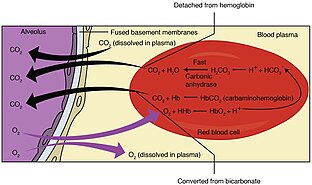Chloride shift

Chloride shift (also known as the Hamburger phenomenon or lineas phenomenon, named after
Mechanism
Cell membranes are generally impermeable to charged ions (i.e. H+, HCO3− ) but RBCs are able to exchange bicarbonate for chloride using the anion exchanger protein
The opposite process occurs in the pulmonary capillaries of the lungs when the PO2 rises and PCO2 falls, and the Haldane effect occurs (release of CO2 from hemoglobin during oxygenation). This releases hydrogen ions from hemoglobin, increases free H+ concentration within RBCs, and shifts the equilibrium towards CO2 and water formation from bicarbonate. The subsequent decrease in intracellular bicarbonate concentration reverses chloride-bicarbonate exchange: bicarbonate moves into the cell in exchange for chloride moving out. Inward movement of bicarbonate via the Band 3 exchanger allows carbonic anhydrase to convert it to CO2 for expiration.[3]
The chloride shift may also regulate the affinity of
Reaction
Reaction (as it occurs in the pulmonary capillaries)
RBC PLASMA HCO3− <-- <-- <-- HCO3− K+ Na+ Cl− --> --> --> --> Cl−
Bicarbonate in the red blood cell (RBC) exchanging with chloride from plasma in the lungs.
The underlying properties creating the chloride shift are the presence of carbonic anhydrase within the RBCs but not the plasma, and the permeability of the RBC membrane to carbon dioxide and bicarbonate ion but not to hydrogen ion. Continuous process of carbonic acid dissociation and outflow of bicarbonate ions would eventually lead to a change of intracellular electric potential because of lasting H+ ions. Inflow of chloride ions maintains electrical neutrality of a cell. The net direction of bicarbonate-chloride exchange (bicarbonate out of RBCs in the systemic capillaries, bicarbonate into RBCs at pulmonary capillaries) proceeds in the direction that decreases the sum of the electrochemical potentials for the chloride and bicarbonate ions being transported.
